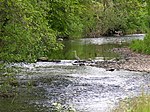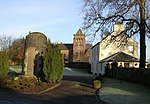Killearn

Killearn (Scottish Gaelic: Cill Fhearann, from orig. Ceann Fhearann, "Head/End of (the) Land/Territory" – until the 15th century when Ceann was replaced by Cill; denoting the presence of a house of worship) – is a small village of approximately 1700 people in the Stirling council area of Scotland. The village has its own primary school, a local Co-Op store, a pre and post school club - The Little Outdoor Classroom, and two nurseries - Mulberrybush Montessori and Heron HouseThe village is approximately 15 miles (24 kilometres) north of Glasgow, 7 miles (11 kilometres) east of Loch Lomond, and sits on the northwest flank of the Campsie Fells, most predominantly in the shadow of the volcanic plug of Dumgoyne, overlooking the confluence of the Endrick Water and Blane Water. The Glengoyne whisky distillery, Loch Lomond and the Trossachs National Park and West Highland Way long-distance walking route are situated close to the village. The residential special school of Ballikinrain is also located in Killearn Parish, and caters for boys with special needs from throughout Scotland. (The school has been earmarked for closure in July 2015). The Church of Scotland congregation at Killearn Kirk falls under the Presbytery of Stirling, within the Synod of Forth. Within the Roman Catholic Church, Killearn falls under the Parish of Saint Anthony within the Roman Catholic Archdiocese of Saint Andrews and Edinburgh; although the Catholic community in Killearn is served by St. Anthony's Church in the neighbouring town of Balfron.
Excerpt from the Wikipedia article Killearn (License: CC BY-SA 3.0, Authors, Images).Killearn
Main Street,
Geographical coordinates (GPS) Address Nearby Places Show on map
Geographical coordinates (GPS)
| Latitude | Longitude |
|---|---|
| N 56.042 ° | E -4.368 ° |
Address
Main Street
Main Street
G63 9RQ
Scotland, United Kingdom
Open on Google Maps








